Publications and media
Does co-producing Climate Services with farmers lead to higher usability?
Climate Services for farmers are essential tools to assist decision-making. They help users to better understand weather risks, which are becoming increasingly hard for farmers to predict in the conte...
Published on
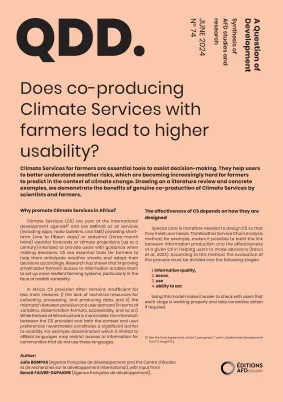
The human rights-based approach: A lever for transformation
92% of the SDG targets are rooted in the international corpus of human rights. In this context, the French Ministry of Europe and Foreign Affairs' human rights strategy calls for "support for human ri...
Published on
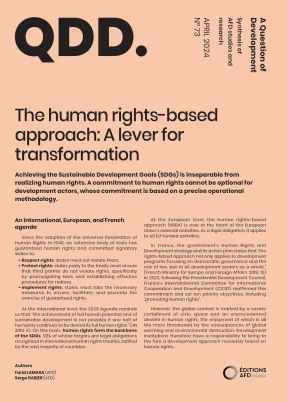
How can healthcare for older people in sub-Saharan Africa be improved?
In Africa, the demographic transitions in progress are accompanied by a predicted aging of the population. This phenomenon cannot be ignored in future political decisions. Nations south of the Sahara...
Published on

How to assess coastal flood risk in data-sparse coastal lowlands? Accurate information on land elevation is k...
With rising sea level, the densely populated coastal lowlands in the world, many of them located in the Global South, face increasing flood risks and thus require reliable flood risk assessments. As t...
Published on

Is the Environmental and Social Impact Assessment (ESIA) a reliable tool for improving the management of minin...
“Environmental and Social Impact Assessment (ESIA)” refers to the procedure by which the owner of a mining project is required to assess the environmental and social impact of the project with a view...
Published on

Virtual universities in Africa: The challenges that need to be overcome
An increasing number of African nations now offer virtual universities. This is an appropriate (though partial) response to the challenge of the massification of higher education. However, the rollout...
Published on
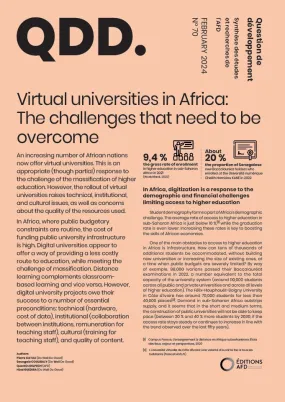
Women’s Economic Empowerment in Africa
Reducing the labor market gender gap is crucial for ensuring women’s economic empowerment. Despite recording one of the highest participation rate in the workforce, women in Sub-Saharan Africa still f...
Published on

The minerals essential to the energy and digital transitions: An opportunity for Africa?
With the acceleration of the energy and digital transitions, global demand for critical minerals has grown exponentially in recent years. Africa, with its extensive and still relatively unexploited re...
Published on

How are public development banks operationalizing the Sustainable Development Goals?
Financial institutions, especially public development banks (PDBs), have developed a range of frameworks and tools to operationalize the Sustainable Development Goals (SDGs). But what are the strength...
Published on

Irrigated agriculture: A service-based approach to put irrigators at the center of policy formulation
Irrigated agriculture can help address challenges of food security and sovereignty, develop regions and farms, improve trade balance, and contribute to climate change adaptation. An irrigated area is...
Published on
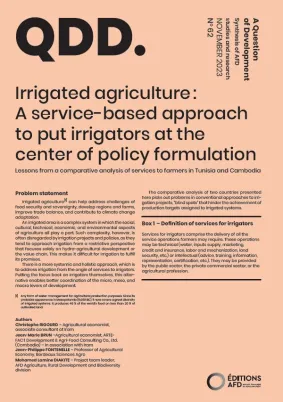
Coastal erosion in the Comoros: How are perceptions and risks of maladaptation linked?
Coastal erosion and marine flooding today pose a major challenge for the Comoros and are likely to increase in the future. To cope with this, the local population mainly favors “hard” adaptation by st...
Published on

Strengthening climate services in Africa by incorporating local knowledge
https://issuu.com/objectif-developpement/docs/qdd_60_vf_bdLocal knowledge is currently attracting growing interest on the international stage, in particular for its contribution to biodiversity conser...
Published on
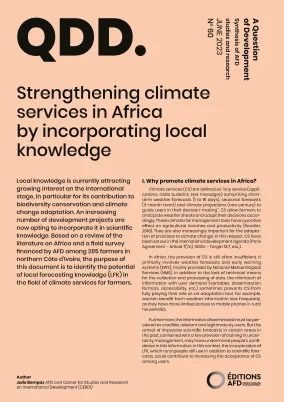
Employment in a zero net emissions future in Costa Rica: Renewable energy to enable widespread benefits for th...
In pursuit of a "3D" economy (decentralized, digitized and decarbonized), Costa Rica is encouraging transformations to work towards the year 2050 through its National Decarbonization Plan (NDP) and th...
Published on
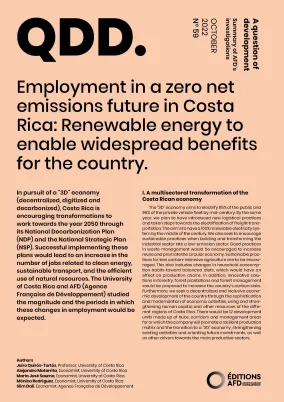
Greening China’s investments in Africa: issues and challenges
The 8th Forum on China-Africa Cooperation (FOCAC), which was held in Dakar in November 2021, strengthened the pillars of a “new era” of China-Africa cooperation in various fields, including energy, wh...
Published on

E-commerce tax: an opportunity for Africa?
The digital transformation does away with the need for multinational enterprises to be physically present in the countries where they operate. This poses a major challenge in terms of taxation and los...
Published on
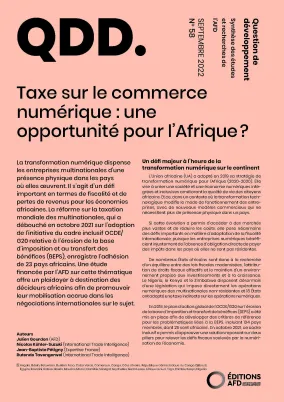
How do international organizations address the articulation between gender and climate?
It is not prior to the 2010s that the gendered aspects of climate action were comprehensively addressed and started to permeate the climate change agenda through the Conferences of Parties. Over the p...
Published on
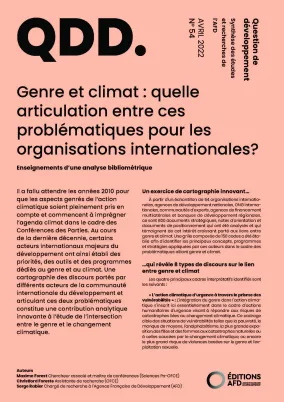
Measuring the impact of development projects using geospatial impact evaluation methods
Geospatial impact evaluation (GIE) methods were developed because of the increasing availability of geospatial data. They are particularly suited to evaluating the impact of development aid programmes...
Published on

Building Data Infrastructure in Development Contexts: Lessons from the #Data4COVID19 Africa Challenge
COVID-19 and other societal threats hamper the ability of development practitioners and stakeholders to address public needs. Bolstering society’s ability to responsibly access, re-use and generate in...
Published on
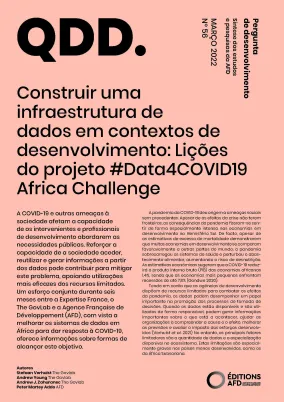
Improving the identification of multiple causes of death in the absence of death certificates
Health developments represent a challenge for healthcare systems and public policy alike. High-income countries developed the multiplecauses-of-death approach, which takes into account all the causes...
Published on
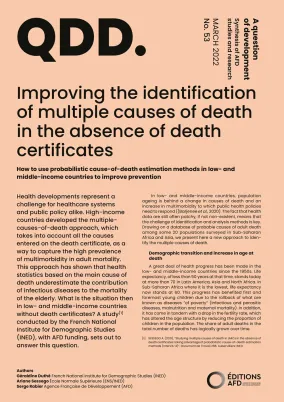
Agricultural information systems in Sub-Saharan Africa: Rethinking the role of governments in the age of priva...
Information systems play a key role in agricultural risk management strategies and production and marketing decision optimisation strategies. This makes them an important tool for poverty reduction in...
Published on
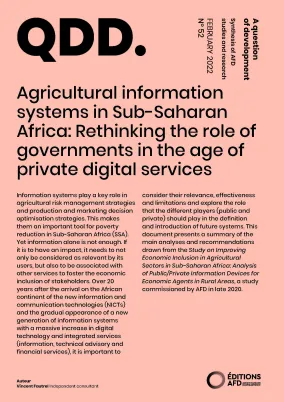
Toward a reliable assessment of the environmental sustainability of territories
The Environmental Sustainability Gap (ESGAP) is an innovative tool for assessing the condition of a territory's environmental functions and how sustainable they are. Despite the sparse and fragmented...
Published on

